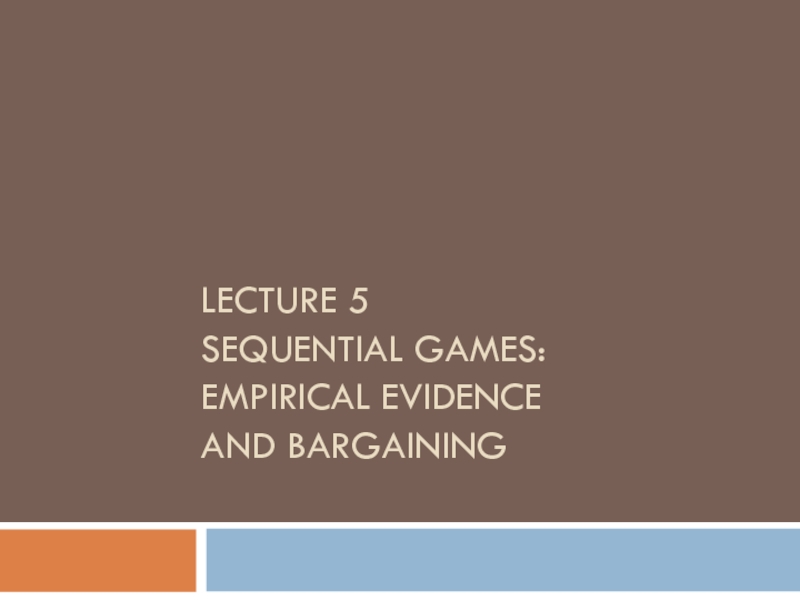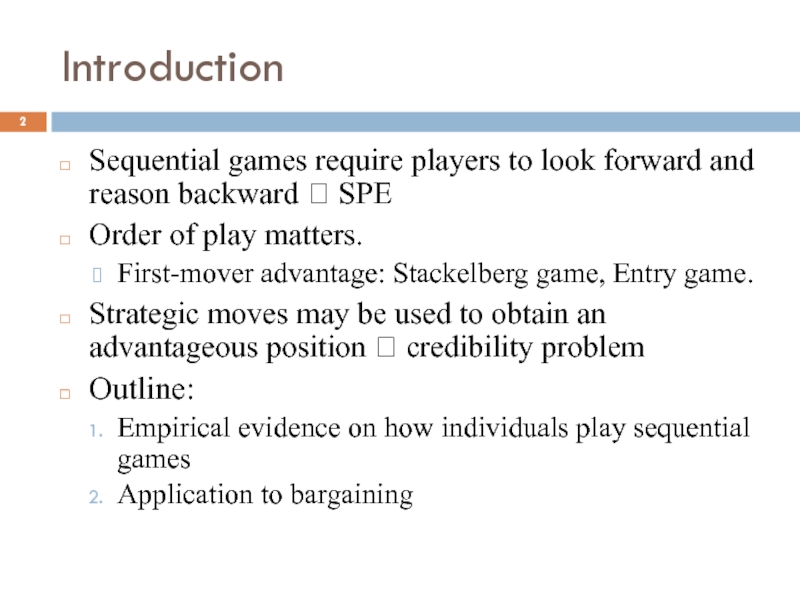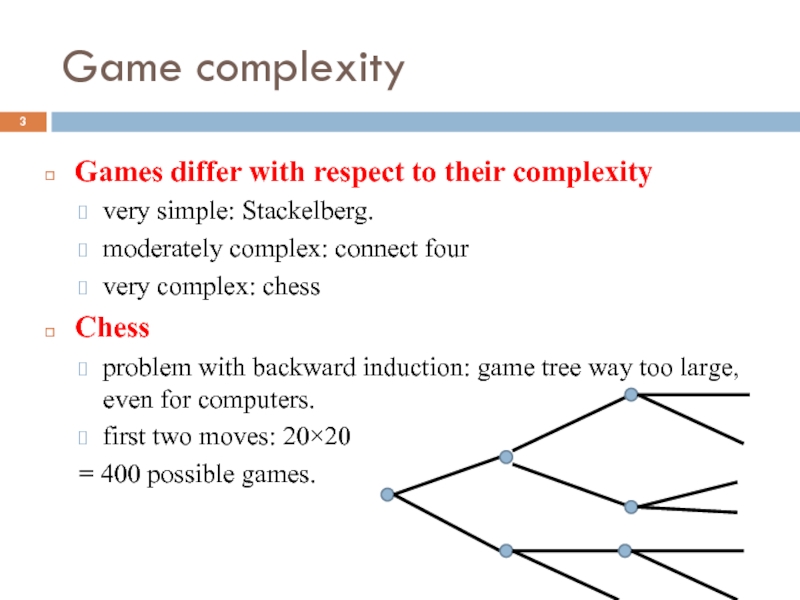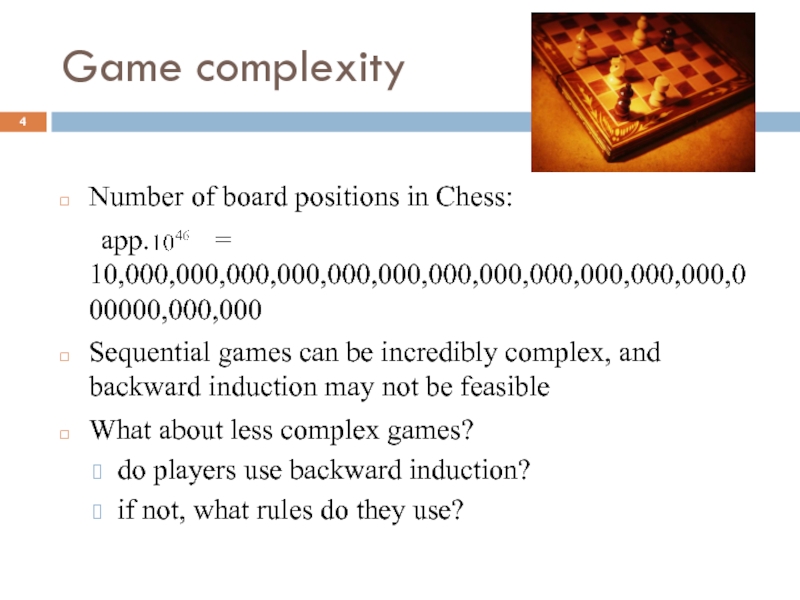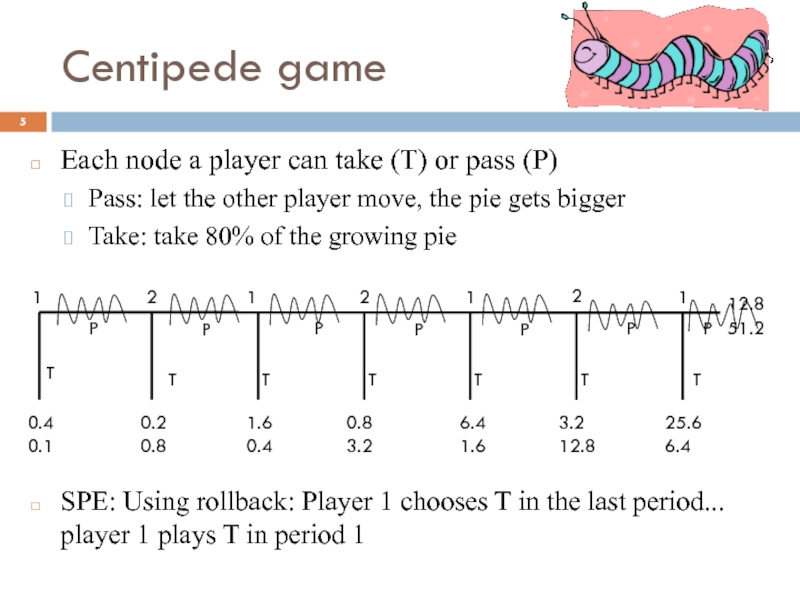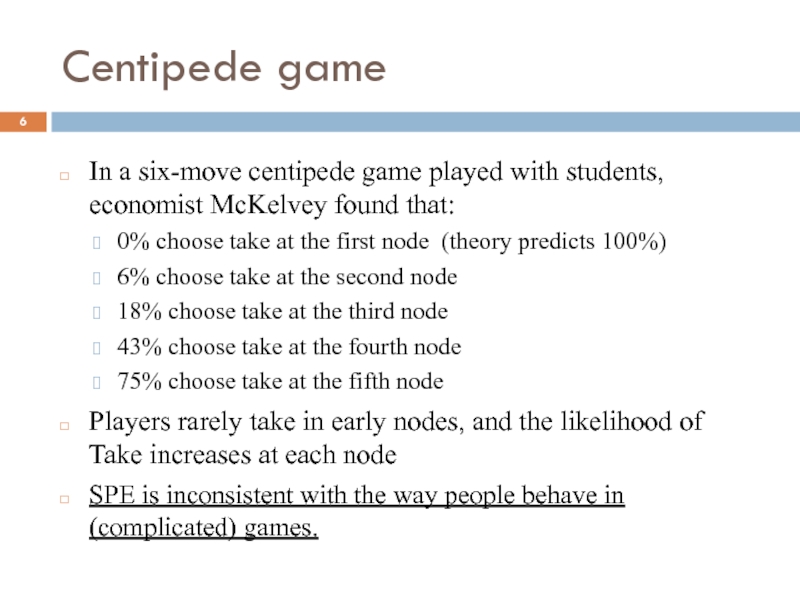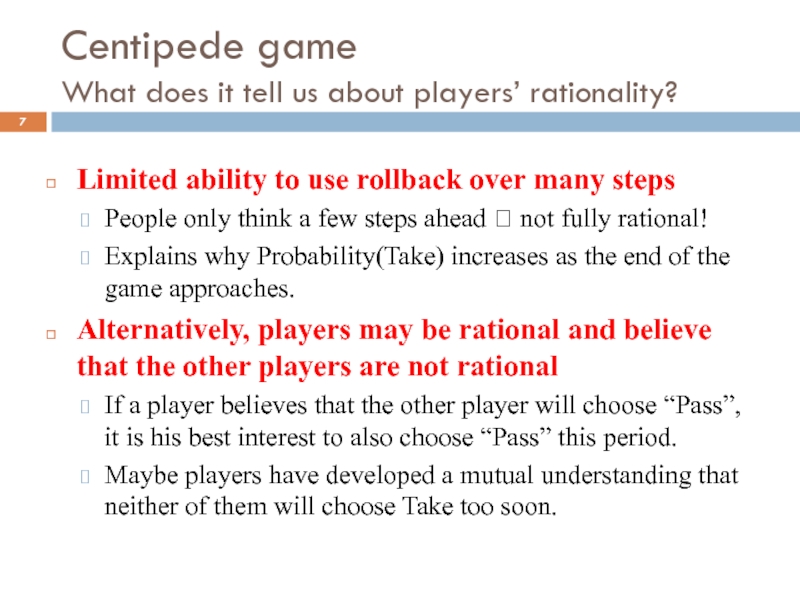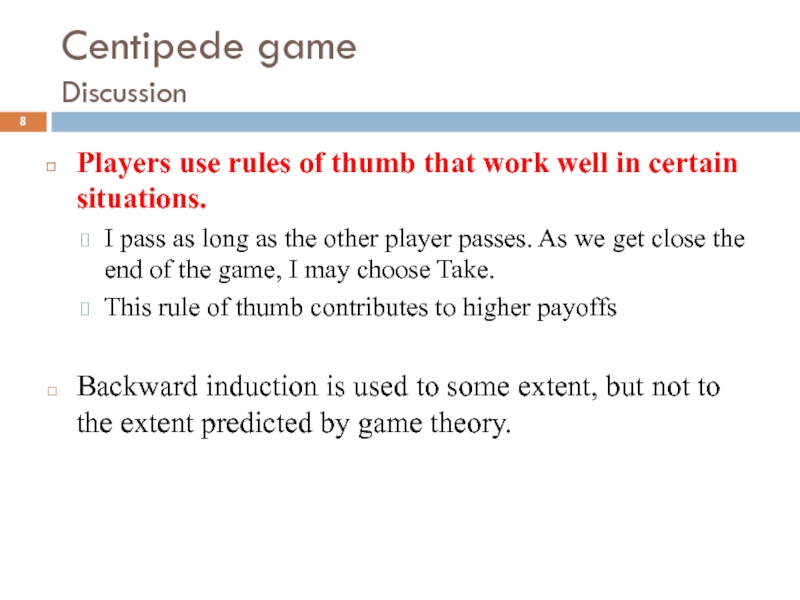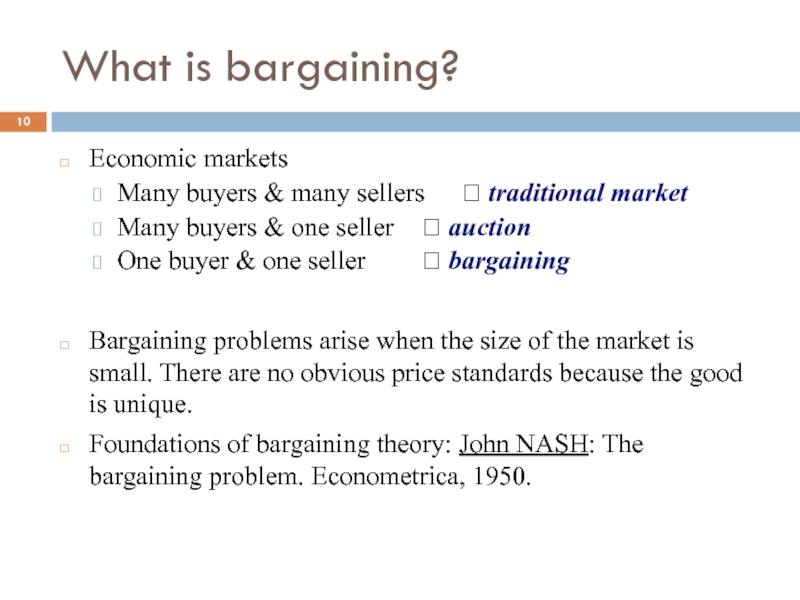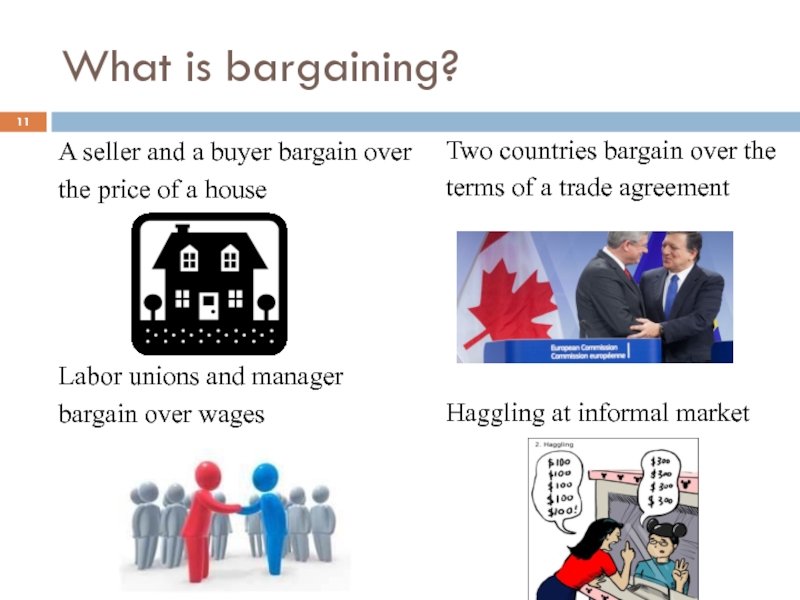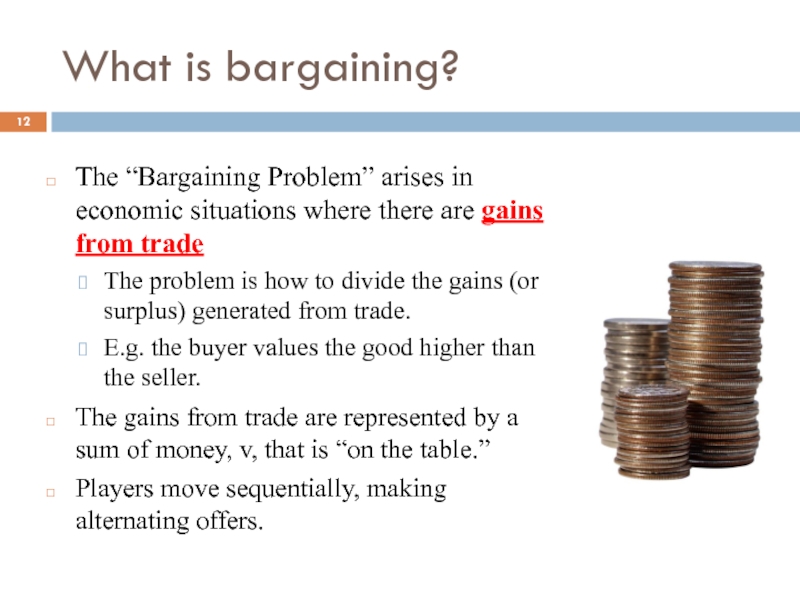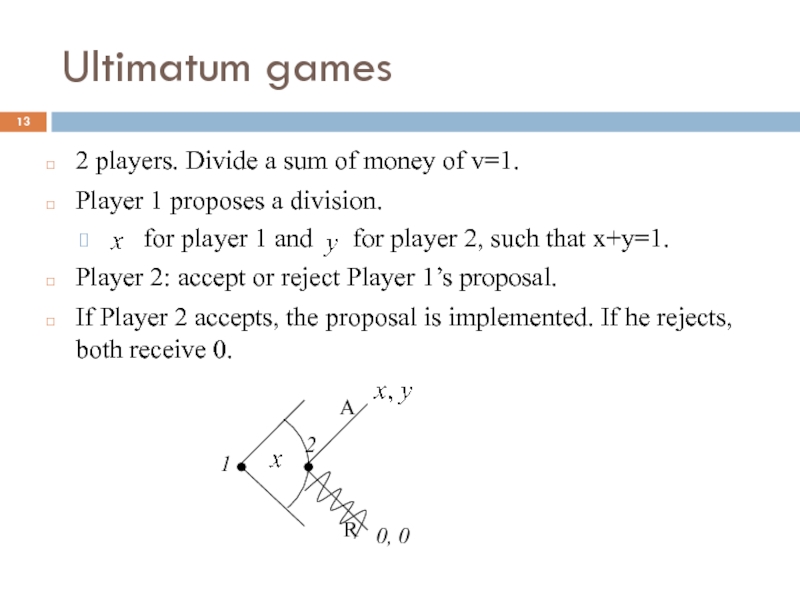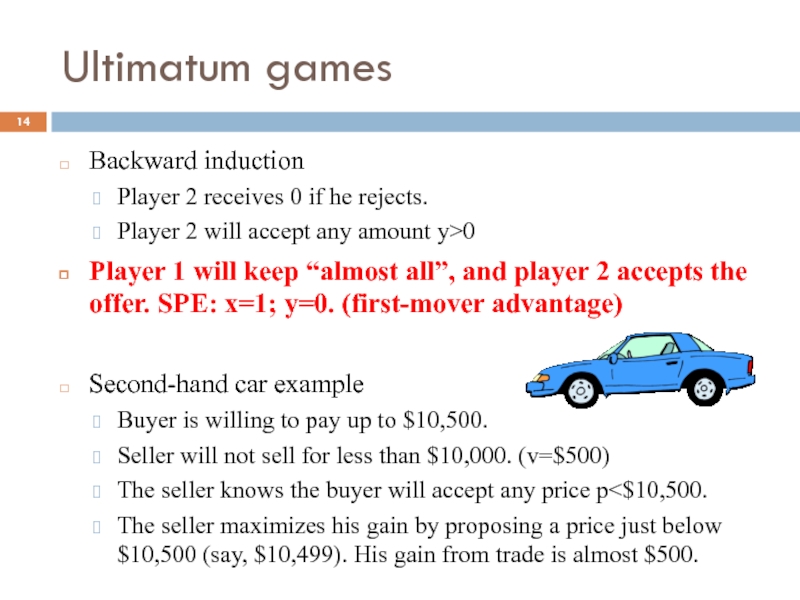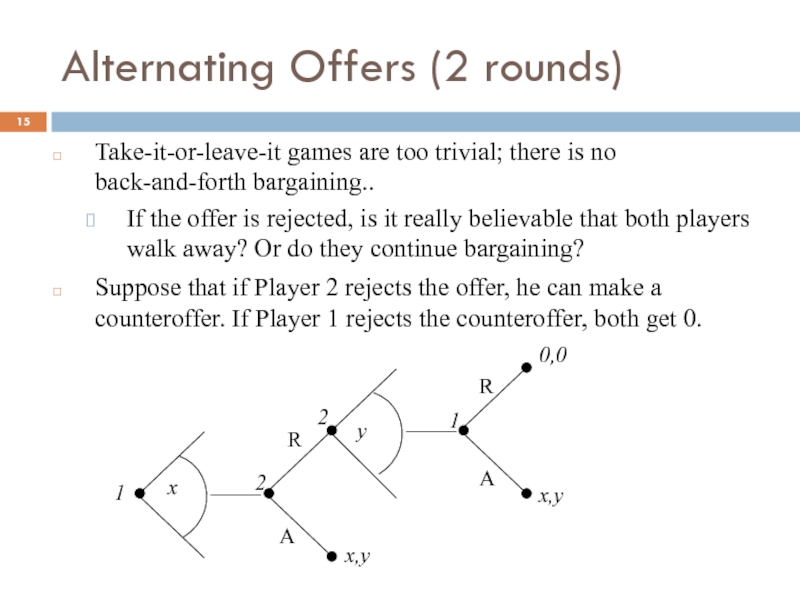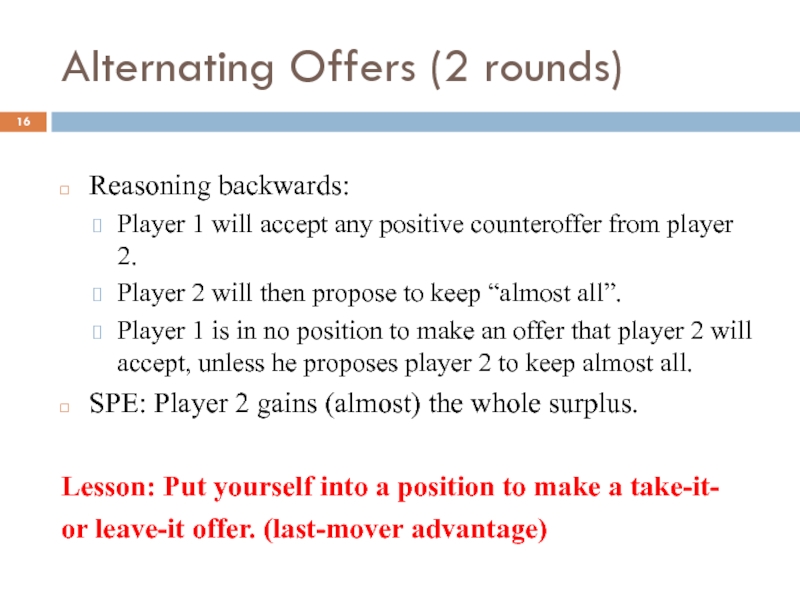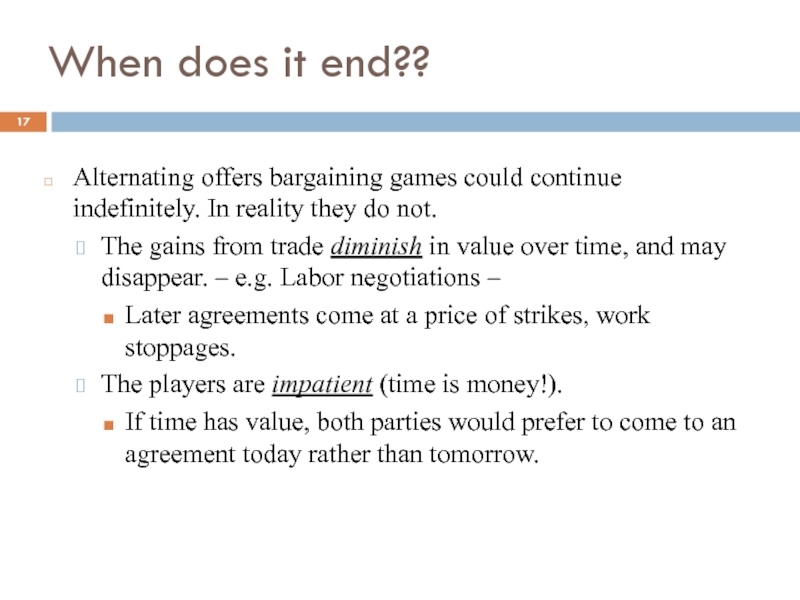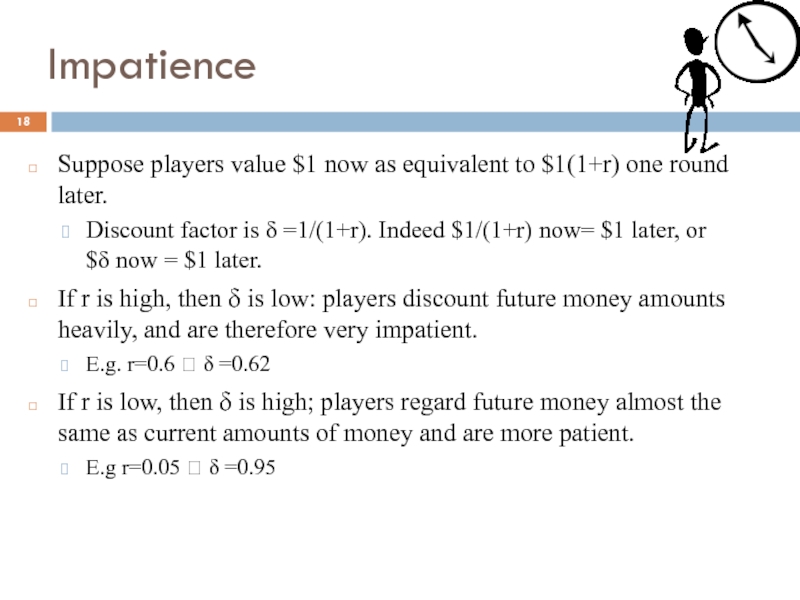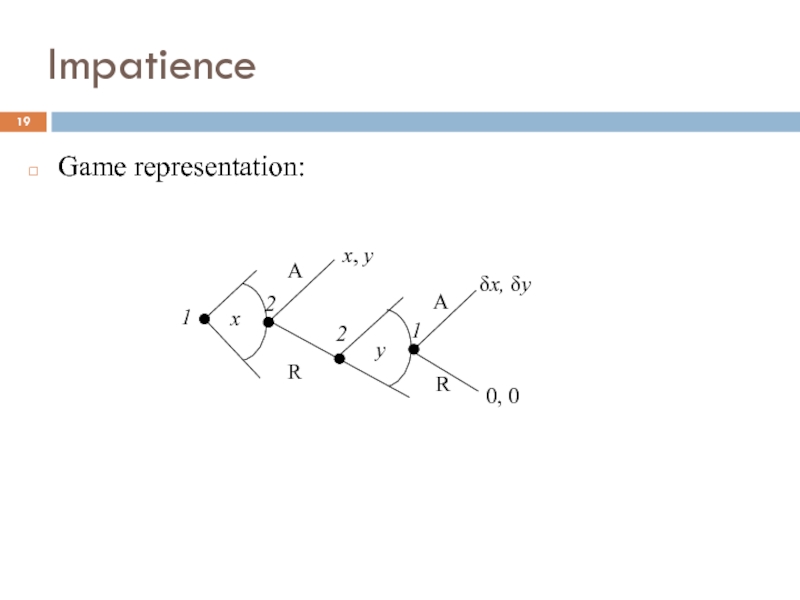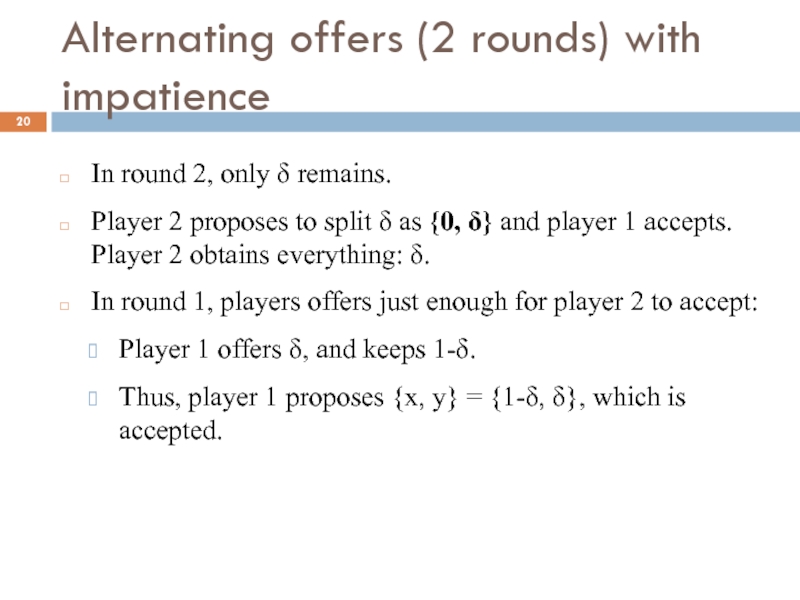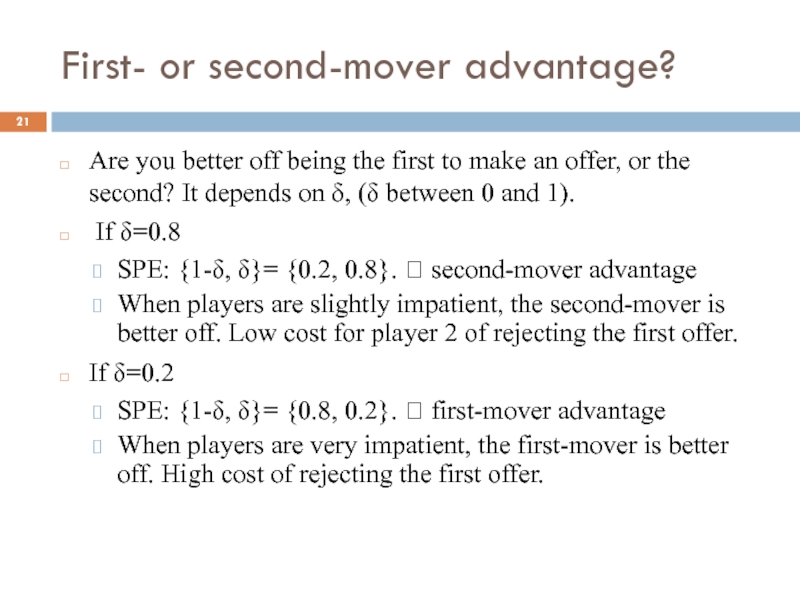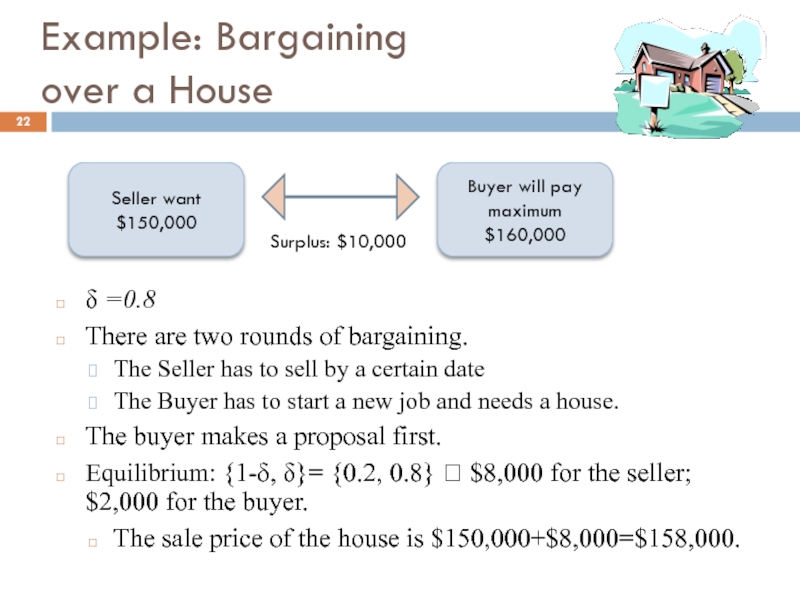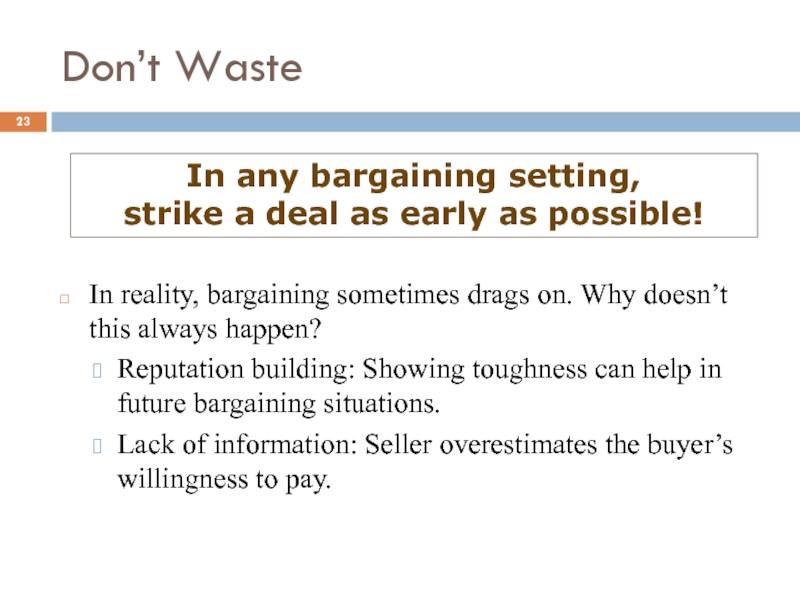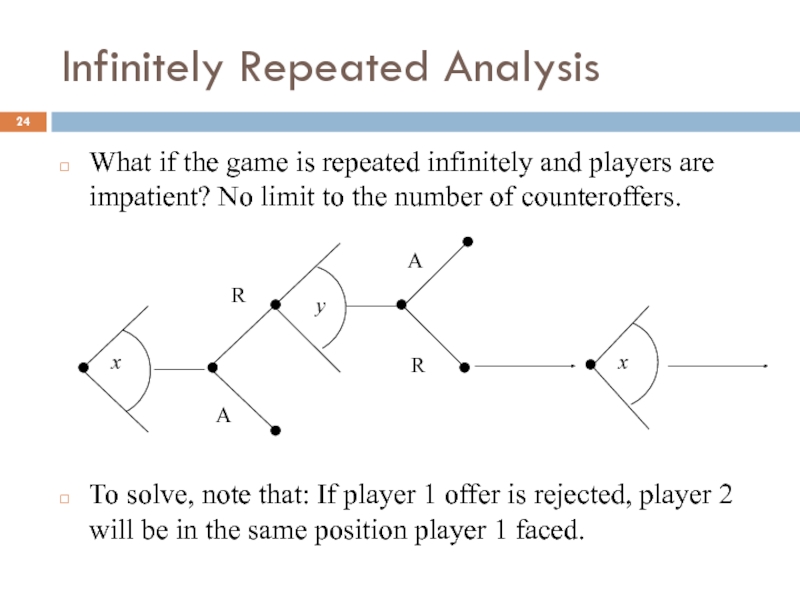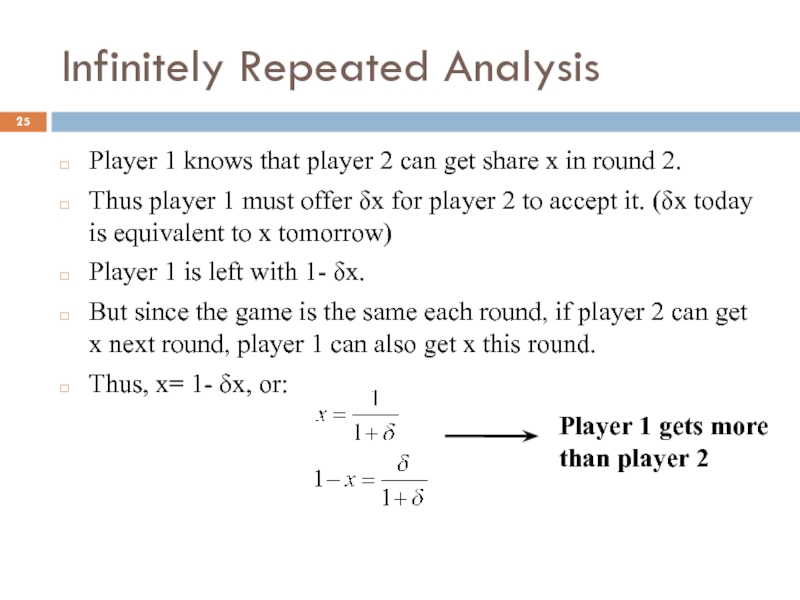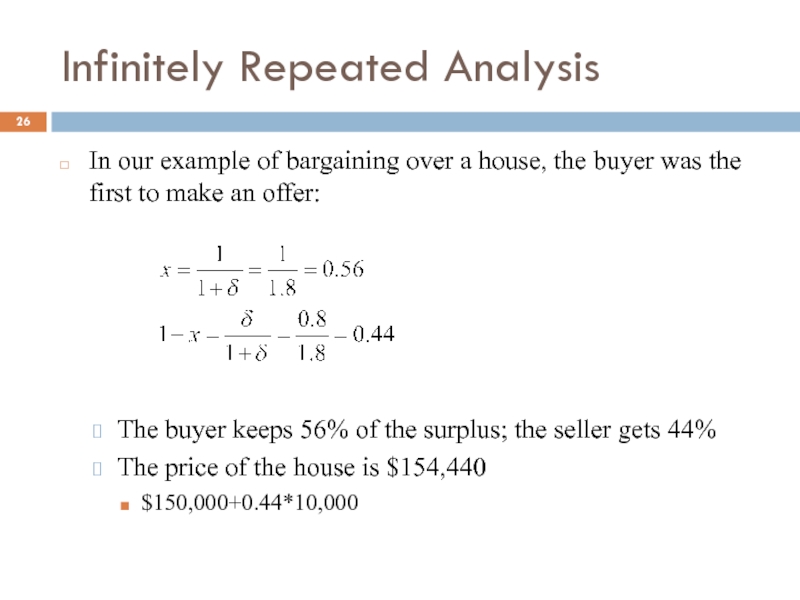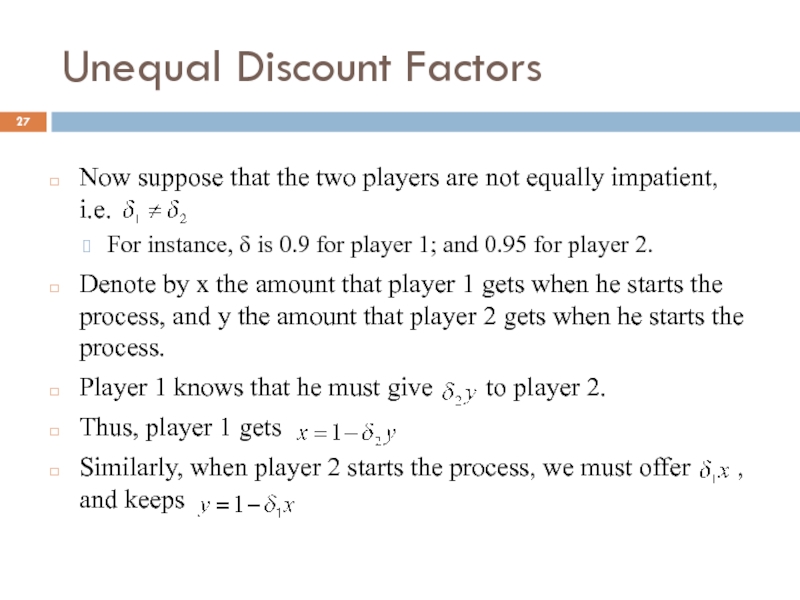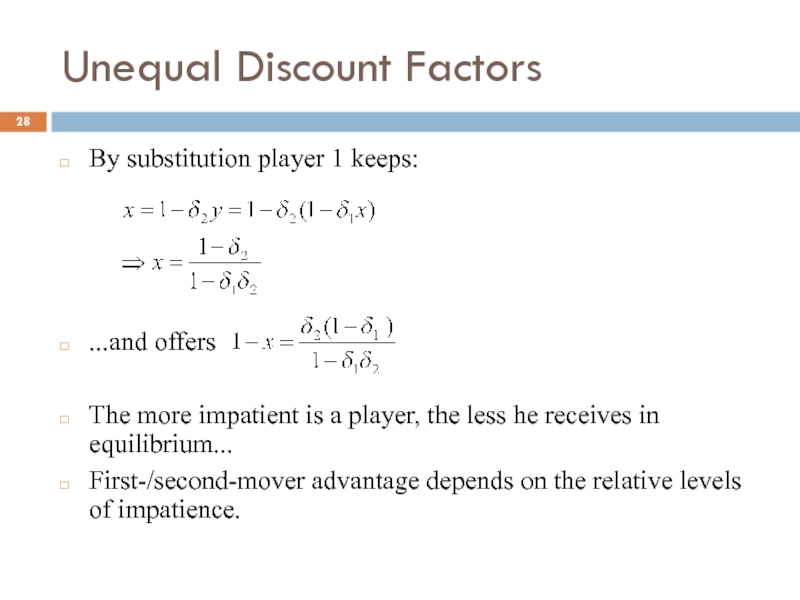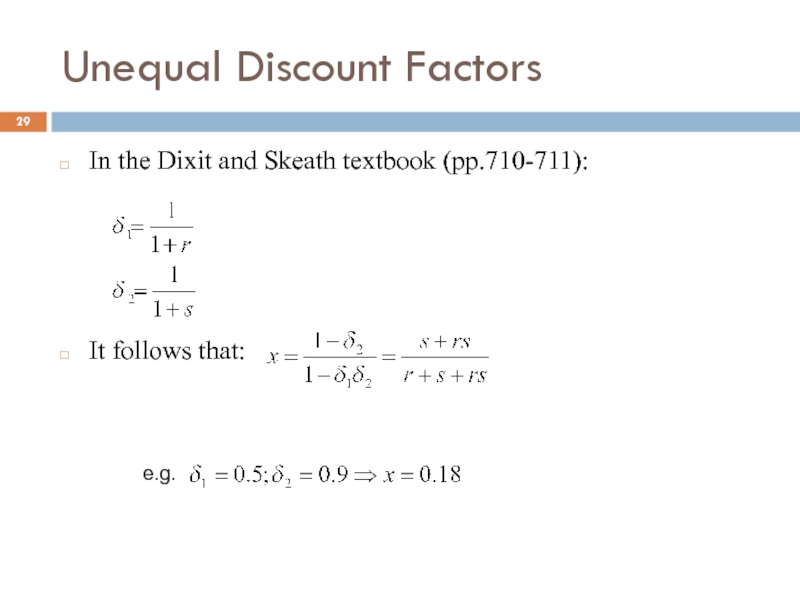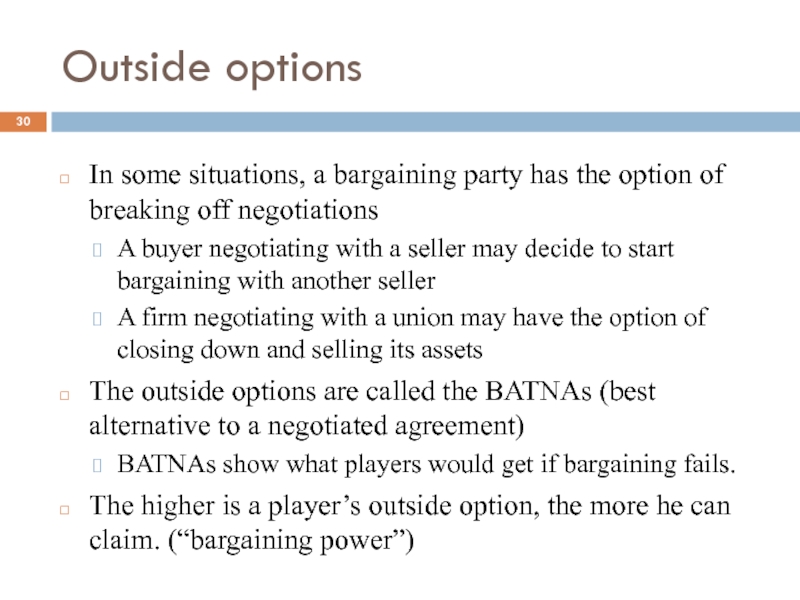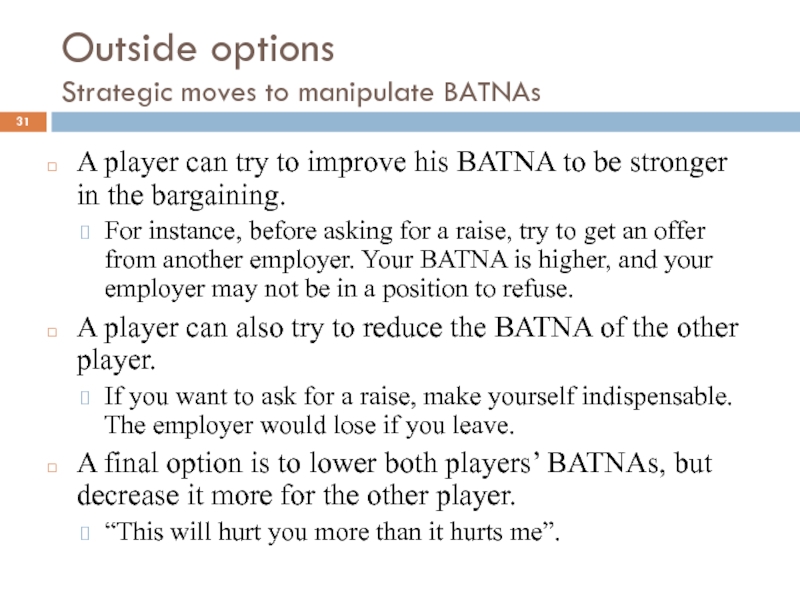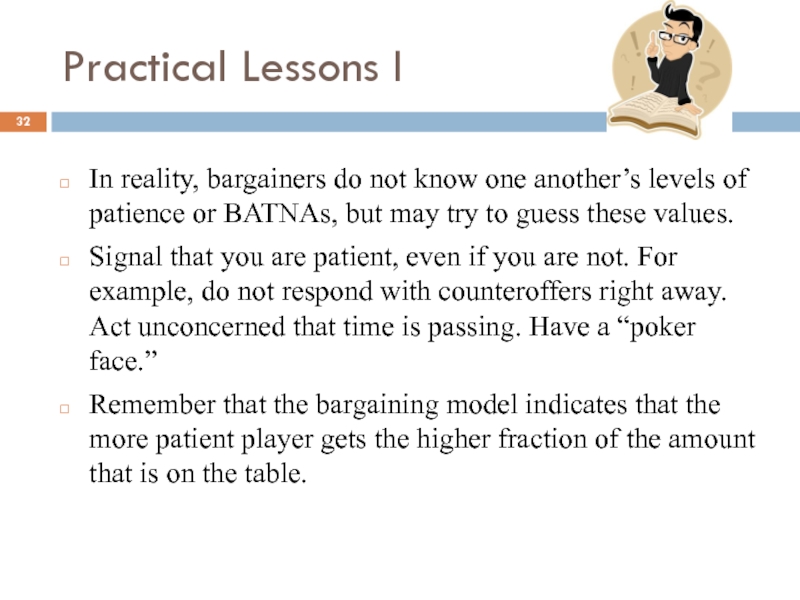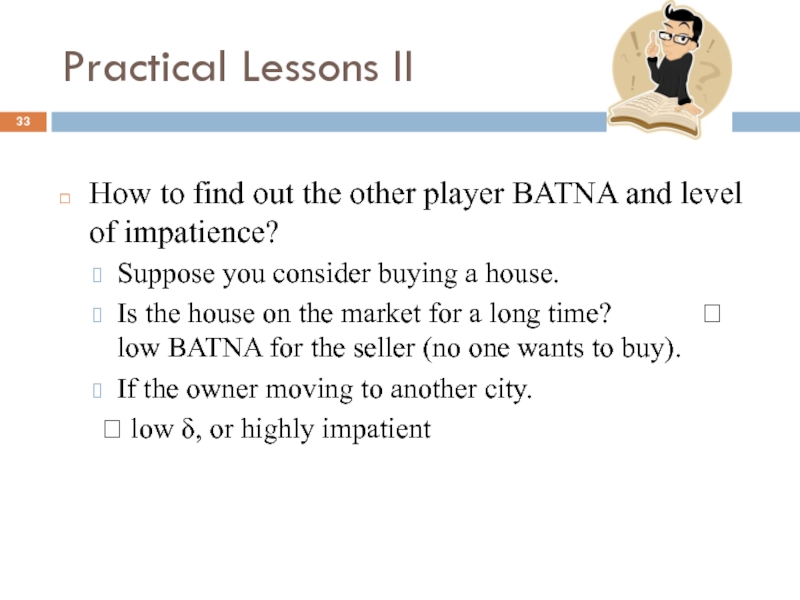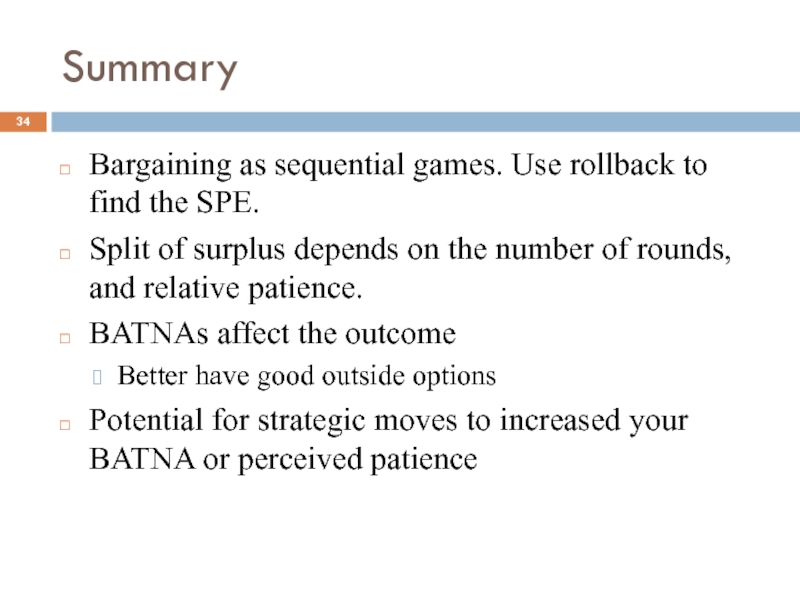- Главная
- Разное
- Дизайн
- Бизнес и предпринимательство
- Аналитика
- Образование
- Развлечения
- Красота и здоровье
- Финансы
- Государство
- Путешествия
- Спорт
- Недвижимость
- Армия
- Графика
- Культурология
- Еда и кулинария
- Лингвистика
- Английский язык
- Астрономия
- Алгебра
- Биология
- География
- Детские презентации
- Информатика
- История
- Литература
- Маркетинг
- Математика
- Медицина
- Менеджмент
- Музыка
- МХК
- Немецкий язык
- ОБЖ
- Обществознание
- Окружающий мир
- Педагогика
- Русский язык
- Технология
- Физика
- Философия
- Химия
- Шаблоны, картинки для презентаций
- Экология
- Экономика
- Юриспруденция
Sequential games. Empirical evidence and bargaining. (Lecture 5) презентация
Содержание
- 1. Sequential games. Empirical evidence and bargaining. (Lecture 5)
- 2. Introduction Sequential games require players to look
- 3. Game complexity Games differ with respect to
- 4. Game complexity Number of board positions in
- 5. Centipede game Each node a player can
- 6. Centipede game In a six-move centipede game
- 7. Centipede game What does it tell us
- 8. Centipede game Discussion Players use rules of
- 9. BARGAINING GAMES An Application of Sequential Move Games
- 10. What is bargaining? Economic markets Many buyers
- 11. What is bargaining? A seller and a
- 12. The “Bargaining Problem” arises in economic situations
- 13. Ultimatum games 2 players. Divide a sum
- 14. Ultimatum games Backward induction Player 2
- 15. Alternating Offers (2 rounds) Take-it-or-leave-it games are
- 16. Alternating Offers (2 rounds) Reasoning backwards: Player
- 17. When does it end?? Alternating offers bargaining
- 18. Impatience Suppose players value $1 now as
- 19. Impatience Game representation:
- 20. Alternating offers (2 rounds) with impatience In
- 21. First- or second-mover advantage? Are you better
- 22. Example: Bargaining over a House δ
- 23. Don’t Waste In any bargaining setting,
- 24. Infinitely Repeated Analysis What if the game
- 25. Infinitely Repeated Analysis Player 1 knows that
- 26. Infinitely Repeated Analysis In our example of
- 27. Unequal Discount Factors Now suppose that the
- 28. Unequal Discount Factors By substitution player 1
- 29. Unequal Discount Factors In the Dixit and
- 30. Outside options In some situations, a bargaining
- 31. A player can try to improve his
- 32. Practical Lessons I In reality, bargainers do
- 33. Practical Lessons II How to find out
- 34. Summary Bargaining as sequential games. Use rollback
Слайд 2Introduction
Sequential games require players to look forward and reason backward ?
Order of play matters.
First-mover advantage: Stackelberg game, Entry game.
Strategic moves may be used to obtain an advantageous position ? credibility problem
Outline:
Empirical evidence on how individuals play sequential games
Application to bargaining
Слайд 3Game complexity
Games differ with respect to their complexity
very simple: Stackelberg.
moderately
very complex: chess
Chess
problem with backward induction: game tree way too large, even for computers.
first two moves: 20×20
= 400 possible games.
Слайд 4Game complexity
Number of board positions in Chess:
app.
Sequential games can be incredibly complex, and backward induction may not be feasible
What about less complex games?
do players use backward induction?
if not, what rules do they use?
Слайд 5Centipede game
Each node a player can take (T) or pass (P)
Pass:
Take: take 80% of the growing pie
SPE: Using rollback: Player 1 chooses T in the last period... player 1 plays T in period 1
0.4
0.1
0.2
0.8
1.6
0.4
0.8
3.2
6.4
1.6
1
1
2
2
T
T
T
T
P
P
P
P
3.2
12.8
25.6
6.4
12.8
51.2
P
P
T
T
T
2
1
1
P
Слайд 6Centipede game
In a six-move centipede game played with students, economist McKelvey
0% choose take at the first node (theory predicts 100%)
6% choose take at the second node
18% choose take at the third node
43% choose take at the fourth node
75% choose take at the fifth node
Players rarely take in early nodes, and the likelihood of Take increases at each node
SPE is inconsistent with the way people behave in (complicated) games.
Слайд 7Centipede game
What does it tell us about players’ rationality?
Limited ability to
People only think a few steps ahead ? not fully rational!
Explains why Probability(Take) increases as the end of the game approaches.
Alternatively, players may be rational and believe that the other players are not rational
If a player believes that the other player will choose “Pass”, it is his best interest to also choose “Pass” this period.
Maybe players have developed a mutual understanding that neither of them will choose Take too soon.
Слайд 8Centipede game
Discussion
Players use rules of thumb that work well in certain
I pass as long as the other player passes. As we get close the end of the game, I may choose Take.
This rule of thumb contributes to higher payoffs
Backward induction is used to some extent, but not to the extent predicted by game theory.
Слайд 10What is bargaining?
Economic markets
Many buyers & many sellers ? traditional market
Many buyers
One buyer & one seller ? bargaining
Bargaining problems arise when the size of the market is small. There are no obvious price standards because the good is unique.
Foundations of bargaining theory: John NASH: The bargaining problem. Econometrica, 1950.
Слайд 11What is bargaining?
A seller and a buyer bargain over
the price
Labor unions and manager
bargain over wages
Two countries bargain over the
terms of a trade agreement
Haggling at informal market
Слайд 12The “Bargaining Problem” arises in economic situations where there are gains
The problem is how to divide the gains (or surplus) generated from trade.
E.g. the buyer values the good higher than the seller.
The gains from trade are represented by a sum of money, v, that is “on the table.”
Players move sequentially, making alternating offers.
What is bargaining?
Слайд 13Ultimatum games
2 players. Divide a sum of money of v=1.
Player 1
for player 1 and for player 2, such that x+y=1.
Player 2: accept or reject Player 1’s proposal.
If Player 2 accepts, the proposal is implemented. If he rejects, both receive 0.
2
A
R
0, 0
1
Слайд 14Ultimatum games
Backward induction
Player 2 receives 0 if he rejects.
Player 2
Player 1 will keep “almost all”, and player 2 accepts the offer. SPE: x=1; y=0. (first-mover advantage)
Second-hand car example
Buyer is willing to pay up to $10,500.
Seller will not sell for less than $10,000. (v=$500)
The seller knows the buyer will accept any price p<$10,500.
The seller maximizes his gain by proposing a price just below $10,500 (say, $10,499). His gain from trade is almost $500.
Слайд 15Alternating Offers (2 rounds)
Take-it-or-leave-it games are too trivial; there is no
If the offer is rejected, is it really believable that both players walk away? Or do they continue bargaining?
Suppose that if Player 2 rejects the offer, he can make a counteroffer. If Player 1 rejects the counteroffer, both get 0.
x
y
A
R
A
x,y
x,y
R
0,0
1
1
2
2
Слайд 16Alternating Offers (2 rounds)
Reasoning backwards:
Player 1 will accept any positive counteroffer
Player 2 will then propose to keep “almost all”.
Player 1 is in no position to make an offer that player 2 will accept, unless he proposes player 2 to keep almost all.
SPE: Player 2 gains (almost) the whole surplus.
Lesson: Put yourself into a position to make a take-it-
or leave-it offer. (last-mover advantage)
Слайд 17When does it end??
Alternating offers bargaining games could continue indefinitely. In
The gains from trade diminish in value over time, and may disappear. – e.g. Labor negotiations –
Later agreements come at a price of strikes, work stoppages.
The players are impatient (time is money!).
If time has value, both parties would prefer to come to an agreement today rather than tomorrow.
Слайд 18Impatience
Suppose players value $1 now as equivalent to $1(1+r) one round
Discount factor is δ =1/(1+r). Indeed $1/(1+r) now= $1 later, or $δ now = $1 later.
If r is high, then δ is low: players discount future money amounts heavily, and are therefore very impatient.
E.g. r=0.6 ? δ =0.62
If r is low, then δ is high; players regard future money almost the same as current amounts of money and are more patient.
E.g r=0.05 ? δ =0.95
Слайд 20Alternating offers (2 rounds) with impatience
In round 2, only δ remains.
Player 2 proposes to split δ as {0, δ} and player 1 accepts. Player 2 obtains everything: δ.
In round 1, players offers just enough for player 2 to accept:
Player 1 offers δ, and keeps 1-δ.
Thus, player 1 proposes {x, y} = {1-δ, δ}, which is accepted.
Слайд 21First- or second-mover advantage?
Are you better off being the first to
If δ=0.8
SPE: {1-δ, δ}= {0.2, 0.8}. ? second-mover advantage
When players are slightly impatient, the second-mover is better off. Low cost for player 2 of rejecting the first offer.
If δ=0.2
SPE: {1-δ, δ}= {0.8, 0.2}. ? first-mover advantage
When players are very impatient, the first-mover is better off. High cost of rejecting the first offer.
Слайд 22Example: Bargaining
over a House
δ =0.8
There are two rounds of bargaining.
The Seller has to sell by a certain date
The Buyer has to start a new job and needs a house.
The buyer makes a proposal first.
Equilibrium: {1-δ, δ}= {0.2, 0.8} ? $8,000 for the seller; $2,000 for the buyer.
The sale price of the house is $150,000+$8,000=$158,000.
Seller want $150,000
Buyer will pay maximum $160,000
Surplus: $10,000
Слайд 23Don’t Waste
In any bargaining setting,
In reality, bargaining sometimes drags on. Why doesn’t this always happen?
Reputation building: Showing toughness can help in future bargaining situations.
Lack of information: Seller overestimates the buyer’s willingness to pay.
Слайд 24Infinitely Repeated Analysis
What if the game is repeated infinitely and players
To solve, note that: If player 1 offer is rejected, player 2 will be in the same position player 1 faced.
x
y
A
R
A
R
x
Слайд 25Infinitely Repeated Analysis
Player 1 knows that player 2 can get share
Thus player 1 must offer δx for player 2 to accept it. (δx today is equivalent to x tomorrow)
Player 1 is left with 1- δx.
But since the game is the same each round, if player 2 can get x next round, player 1 can also get x this round.
Thus, x= 1- δx, or:
Player 1 gets more
than player 2
Слайд 26Infinitely Repeated Analysis
In our example of bargaining over a house, the
The buyer keeps 56% of the surplus; the seller gets 44%
The price of the house is $154,440
$150,000+0.44*10,000
Слайд 27Unequal Discount Factors
Now suppose that the two players are not equally
For instance, δ is 0.9 for player 1; and 0.95 for player 2.
Denote by x the amount that player 1 gets when he starts the process, and y the amount that player 2 gets when he starts the process.
Player 1 knows that he must give to player 2.
Thus, player 1 gets
Similarly, when player 2 starts the process, we must offer , and keeps
Слайд 28Unequal Discount Factors
By substitution player 1 keeps:
...and offers
The more impatient is
First-/second-mover advantage depends on the relative levels of impatience.
Слайд 30Outside options
In some situations, a bargaining party has the option of
A buyer negotiating with a seller may decide to start bargaining with another seller
A firm negotiating with a union may have the option of closing down and selling its assets
The outside options are called the BATNAs (best alternative to a negotiated agreement)
BATNAs show what players would get if bargaining fails.
The higher is a player’s outside option, the more he can claim. (“bargaining power”)
Слайд 31A player can try to improve his BATNA to be stronger
For instance, before asking for a raise, try to get an offer from another employer. Your BATNA is higher, and your employer may not be in a position to refuse.
A player can also try to reduce the BATNA of the other player.
If you want to ask for a raise, make yourself indispensable. The employer would lose if you leave.
A final option is to lower both players’ BATNAs, but decrease it more for the other player.
“This will hurt you more than it hurts me”.
Outside options
Strategic moves to manipulate BATNAs
Слайд 32Practical Lessons I
In reality, bargainers do not know one another’s levels
Signal that you are patient, even if you are not. For example, do not respond with counteroffers right away. Act unconcerned that time is passing. Have a “poker face.”
Remember that the bargaining model indicates that the more patient player gets the higher fraction of the amount that is on the table.
Слайд 33Practical Lessons II
How to find out the other player BATNA and
Suppose you consider buying a house.
Is the house on the market for a long time? ? low BATNA for the seller (no one wants to buy).
If the owner moving to another city.
? low δ, or highly impatient
Слайд 34Summary
Bargaining as sequential games. Use rollback to find the SPE.
Split of
BATNAs affect the outcome
Better have good outside options
Potential for strategic moves to increased your BATNA or perceived patience
